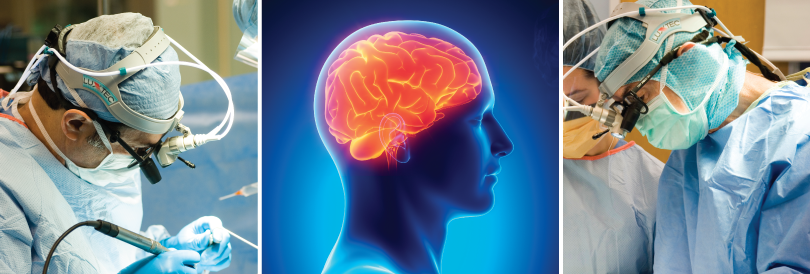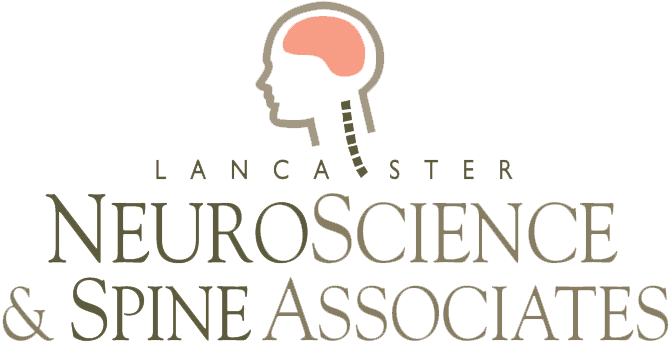Brain Conditions & Procedures
Lancaster NeuroScience & Spine Associates

Providing comprehensive treatment for brain-related conditions.
About our Diagnosis and Procedures
Our Neurosurgeons diagnose and treat a variety of head and brain-related conditions including the list of commonly treated conditions below. From the evaluation and diagnosis process through treatment and recovery our team treats each and every patient with compassionate care and achieves outstanding outcomes.
Commonly treated Neurosurgical Conditions
- Carotid Artery Blockage
Carotid Artery Blockage
The carotid arteries are present on the left and right sides, and supply blood flow to the brain. Certain conditions, such as high cholesterol, high blood pressure, and diabetes can lead to a progressive narrowing of the blood vessels. It is possible that this causes a stroke or can cause an emboli to cause a stroke. Your physician will obtain appropriate studies to evaluate your carotid arteries when indicated.
Procedures used to treat Carotid Artery Blockages
- Carotid Endarterectomy
- Brain Tumors - Benign & Malignant
Brain Tumors – Benign & Malignant
Certain cells in the brain can be the cause of brain tumors. There are both benign and malignant types of brain tumors. Brain tumors can cause many different symptoms in the brain. Imaging studies help detect these, and help determine which treatments are best.
Procedures used to treat Brain Tumors
- Craniotomies and Craniectomies
- Frame-Based and Frameless Stereotactic Neurosurgery
- Gamma Knife Radiosurgery
- Pituitary Tumors
Pituitary Tumors
The pituitary gland is a small endocrine gland located at the base of the brain. It is involved with regulating hormone secretions throughout the body. Tumors that arise in the pituitary gland generally cause problems with hormone balance, or can cause symptoms secondary to compression of structures in the brain that are near the pituitary.
Procedures used to treat Pituitary Tumors
- Transphenoidal Hypophysectomy
- Gamma Knife Radiosurgery
- Craniosynostosis
Craniosynostosis
Craniosynostosis is a term that refers to premature closure of the sutures of a baby’s head. The sutures are the softer spots on a baby’s head. If this occurs, the head can appear misshapen and, in extreme cases, can cause problems with brain development.
Procedures used to treat Craniosynostosis
- Craniotomies and Craniectomies
- Aneurysm
Aneurysm
An aneurysm in the brain occurs with a weakened spot in the blood vessel wall. This may lead to an outpouching of the blood vessel, or an aneurysm. The main medical problem regarding aneurysms is the potential for rupture, causing a subarachnoid hemorrhage, which is a very serious medical condition.
Procedures used to treat Aneurysm
- Craniotomies and Craniectomies
- Arteriovenous Malformation
Arteriovenous Malformation
An arteriovenous malformation (AVM) is a congenital disorder with an abnormal tangle of arteries and veins in the brain. There are certain problems that are typical secondary to AVM’s; however, the most common problem is bleeding from the abnormal vessels, which occurs in approximately 70% of people at some point.
Procedures used to treat Arteriovenous Malformation
- Craniotomies and Craniectomies
- Gamma Knife Radiosurgery
- Hydrocephalus
Hydrocephalus
The brain and spinal cord normally have cerebrospinal fluid (CSF) circulating within the brain and around the spinal cord. If there is an abnormal blockage of the normal flow, hydrocephalus, or a collection of excessive fluid, can develop within the brain. This can happen either in a child or in an adult.
Procedures used to treat Hydrocephalus
- Ventriculoperitoneal Shunts
- Head Injury
Head Injury
There are many different types of head injuries. Trauma can cause head injuries ranging from very mild (concussion) to very severe or life – threatening head injuries. The problems associated with head injuries generally relate to the location and severity of the head injury which was sustained.
Procedures used to treat Head Injury
- Craniotomies and Craniectomies
- Trigeminal and Glossopharyngeal Neuralgia
Trigeminal and Glossopharyngeal Neuralgia
These conditions refer to a type of pain felt either in the face or in the back of the throat. The cause of this pain is typically unknown. The diagnosis is made after careful consultation with your physician. Multiple treatment options are available for these conditions.
Procedures used to treat Trigeminal and Glossopharyngeal Neuralgia
- Craniotomies and Craniectomies
- Gamma Knife Radiosurgery
- Hemifacial Spasm
Hemifacial Spasm
Hemifacial spasm is a condition of unclear cause that causes twitching or spasms on one side of the face and can be a very difficult problem for people to deal with. This condition has multiple treatments.
Procedures used to treat Hemifacial Spasm
- Craniotomies and Craniectomies
- Gamma Knife Radiosurgery
- Intracerebral Hemorrhage
Intracerebral Hemorrhage
Hemifacial spasm is a condition of unclear cause that causes twitching or spasms on one side of the face and can be a very difficult problem for people to deal with. This condition has multiple treatments.
Procedures used to treat Intracerebral Hemorrhage
- Craniotomies and Craniectomies
- Frame-Based and Frameless Stereotactic Neurosurgery
- Gamma Knife Radiosurgery
- Epilepsy
Epilepsy
Intermittent derangement of consciousness, sometimes associated with convulsions, accompanies these conditions. Seizures can be due to congenital problems, or due to acquired factors, such as head injury or other causes leading to brain damage. In recent years, there has been a significant increase in the number of anti-seizure medications available. Seizure surgery has become a successful option in some cases.
Procedures used to treat Epilepsy
- Epileptic Surgery
- Parkinson’s Disease
Parkinson’s Disease
These conditions cause rigidity of the limbs, expressionless face, stooped posture, diminished movements, gait imbalance and falls, and tremor. Decline in memory, depression, diminished eye movements, etc., can also occur.
Procedures used to treat Parkinson’s Disease
- Surgical Treatment of Essential Tremor and Parkinsonian Tremor
Routinely Performed Neurosurgical Procedures
- Carotid Endarterectomy
Carotid Endarterectomy
Carotid endarterectomy is a neurosurgical procedure to remove atherosclerotic plaque from the carotid artery. This procedure can be done under general anesthesia or under a regional block. It involves removing the plaque build-up and therefore reducing the risk of stroke. This procedure is done in patients that are symptomatic from recent TIA’s, or in high-risk patients in which a high-grade stenosis has been discovered by screening studies.
Conditions routinely treated with Carotid Endarterectomy
- Carotid Artery Blockage
- Craniotomies
Craniotomies & Craniectomies
These procedures are performed by neurosurgeons to treat surgical problems including hemorrhagic strokes, trauma, brain tumors, and a multitude of neurological disorders. Utilizing the operating microscope during these delicate procedures allows safe, precise, and less invasive approaches to complex and life-threatening neurosurgical disorders.
Conditions routinely treated with Craniotomies & Craniectomies
- Brain Tumors
- Craniosynostosis
- Aneurysm
- Arteriovenous Malformation
- Head Injury
- Trigeminal and Glossopharyngeal Neuralgia
- Hemifacial Spasm
- Intracerebral Hemorrhage
- Frame-Based and Frameless Stereotactic Neurosurgery
Frame-Based & Frameless Stereotactic Neurosurgery
These procedures involve utilizing sophisticated computer software, pre-operative imaging to allow a very precise and minimally invasive approach to intracranial pathology. Utilizing state-of-the-art stereotactic techniques, very precise and safe approaches are performed in delicate areas within the brain, minimizing risks and improving patient outcomes.
Conditions routinely treated with Frame-Based & Frameless Stereotactic Neurosurgery
- Brain Tumors
- Intracerebral Hemorrhage
- Gamma Knife Radiosurgery
Gamma Knife Radiosurgery
The neurosurgeons at Lancaster NeuroScience & Spine Associates frequently use the gamma knife for treatment of brain tumors and vascular malformations. Through pre-operative planning with the gamma knife radiosurgical team, high doses of radiation are delivered to lesions in a single treatment session. Through sophisticated treatment plans, maximal doses of radiation are delivered to lesions within the brain, minimizing injury to normal structures.
Conditions routinely treated with Gamma Knife Radiosurgery
- Brain Tumors
- Pituitary Tumors
- Arteriovenous Malformation
- Trigeminal & Glossopharyngeal Neuralgia
- Hemifacial Spasm
- Intracerebral Hemorrhage
- Transphenoidal Hypophysectomy
Transphenoidal Hypophysectomy
This procedure is done through a team approach, with exposure being performed by ear, nose, and throat specialists to allow surgical resection of pituitary tumors that cause both endocrinological disturbances or visual loss. This procedure is done utilizing the operating microscope to safely remove tumors affecting the pituitary gland and surrounding structures.
Conditions routinely treated with Transphenoidal Hypophysectomy
- Pituitary Tumors
- Ventriculoperitoneal Shunts
Ventriculoperitoneal Shunts
Ventriculoperitoneal shunts are mechanical devices that are used to treat hydrocephalus and divert cerebral spinal fluid.
Conditions routinely treated with Ventriculoperitoneal Shunts
- Hydrocephalus
- Epileptic Surgery
Epileptic Surgery
Patients with epilepsy refractory to medical therapy, whose seizure focus can be identified in the temporal lobe, can be surgically treated when indicated by removing the focus and origin of the seizures. The neurosurgeon works in conjunction with a neurologist through a team approach, optimal care is provided.
Conditions routinely treated with Epileptic Surgery
- Epilepsy and other Seizure Disorders
- Surgical Treatment of Essential Tremor and Parkinsonian Tremor
Surgical Treatment of Essential Tremor and Parkinsonian Tremor
Utilizing a frame-based stereotactic system, surgical treatments of tremor related to Parkinson’s disease and essential tremor are performed by planting a device to arrest tremor in patients that are refractory to medical therapy. Deep brain stimulator placement achieves excellent tremor control in the appropriate selected patients.
Conditions routinely treated with Surgical Treatment of Essential Tremor and Parkinsonian Tremor
- Parkinson’s Disease, Tremor, and other Movement Disorders
Our Neurosurgeons:






Dr. Eddy Garrido, Dr. Keith Kuhlengel, Dr. Chris Kager, Dr. William Monacci, Dr. James Thurmond and Dr. Kristine Dziurzynski,
Our Physiatrists






